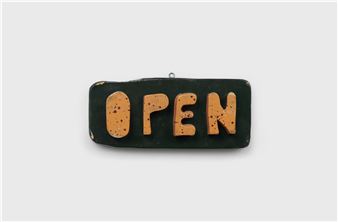Cece Philips: Walking the in Between
Five months have passed since Cece PhilipsвҖҷ previous exhibition with Peres Projects. Or maybe just a single night. The characters we left in the twilight of Berlin now emerge in the dawn light of Seoul. With Walking the In-Between, Philips continues to explore liminal spaces, times, and situations. She invites us to take long strolls through a composite cosmopolis reminiscent of London, Florence and California, draped in the hues of the blue hour, and inhabited by suited women. At this time between day and nightвҖ”between dog and wolf, as a French expression goesвҖ”a mysterious atmosphere lingers over each tableau. We observe each scene from its peripheryвҖ”through an open window, from the opposite sidewalk, from behind a bush or a sofaвҖ”, Cece Philips deliberately placing us in a voyeuristic position. While gazing is usually welcome and anticipated in a gallery, here our glances become вҖңclandestine,вҖқ as writer and researcher Rolake Osabia writes in the short story accompanying the exhibition, entitled вҖңPlease Follow the Yellow Light. Complementing the nine paintings that comprise Walking the In-Between, OsabiaвҖҷs text offers an interpretation of PhilipsвҖҷ work, narrating the wanderings of an anonymous observer, whose perspective could be that of the artist just as well as the viewer.
Through her practice, Philips highlights the privilege implied by such a posture. Belonging anywhere, wandering and watching without risk and without arousing suspicion, is a luxury that many are not afforded. As both an artist and a woman, Philips observes as much as she is observed, and Walking the In-Between straddles both stances. вҖңWhat is it to be seen? What is it to invite the gaze of the other? What is it to belong?вҖқ are questions that run throughout the exhibition.
While the blue hour hinders sight and covers the familiar with a veil of strangeness, it also corresponds to the moment when homes are lit up and windows become showcases, revealing domestic intimacy to passersby. In PhilipsвҖҷ paintings, this is depicted through bright yellow hues that contrast the blue tones of dusk. Like a beacon in the night, this yellow light that the observer in OsabiaвҖҷs story relentlessly pursues conveys a musicality, that of a sociability out of reach. Indeed, behind the windows, through doors left ajar, the scenes we glimpse are blurred and inaccessible, thus leaving us on the threshold of night.

Recommended for you
Five months have passed since Cece PhilipsвҖҷ previous exhibition with Peres Projects. Or maybe just a single night. The characters we left in the twilight of Berlin now emerge in the dawn light of Seoul. With Walking the In-Between, Philips continues to explore liminal spaces, times, and situations. She invites us to take long strolls through a composite cosmopolis reminiscent of London, Florence and California, draped in the hues of the blue hour, and inhabited by suited women. At this time between day and nightвҖ”between dog and wolf, as a French expression goesвҖ”a mysterious atmosphere lingers over each tableau. We observe each scene from its peripheryвҖ”through an open window, from the opposite sidewalk, from behind a bush or a sofaвҖ”, Cece Philips deliberately placing us in a voyeuristic position. While gazing is usually welcome and anticipated in a gallery, here our glances become вҖңclandestine,вҖқ as writer and researcher Rolake Osabia writes in the short story accompanying the exhibition, entitled вҖңPlease Follow the Yellow Light. Complementing the nine paintings that comprise Walking the In-Between, OsabiaвҖҷs text offers an interpretation of PhilipsвҖҷ work, narrating the wanderings of an anonymous observer, whose perspective could be that of the artist just as well as the viewer.
Through her practice, Philips highlights the privilege implied by such a posture. Belonging anywhere, wandering and watching without risk and without arousing suspicion, is a luxury that many are not afforded. As both an artist and a woman, Philips observes as much as she is observed, and Walking the In-Between straddles both stances. вҖңWhat is it to be seen? What is it to invite the gaze of the other? What is it to belong?вҖқ are questions that run throughout the exhibition.
While the blue hour hinders sight and covers the familiar with a veil of strangeness, it also corresponds to the moment when homes are lit up and windows become showcases, revealing domestic intimacy to passersby. In PhilipsвҖҷ paintings, this is depicted through bright yellow hues that contrast the blue tones of dusk. Like a beacon in the night, this yellow light that the observer in OsabiaвҖҷs story relentlessly pursues conveys a musicality, that of a sociability out of reach. Indeed, behind the windows, through doors left ajar, the scenes we glimpse are blurred and inaccessible, thus leaving us on the threshold of night.
Artists on show
Related articles
Peres Projects, a Berlin-based art gallery, opened in Seoul and within a year had outgrown its hotel basement spot and moved to a four-storey space













